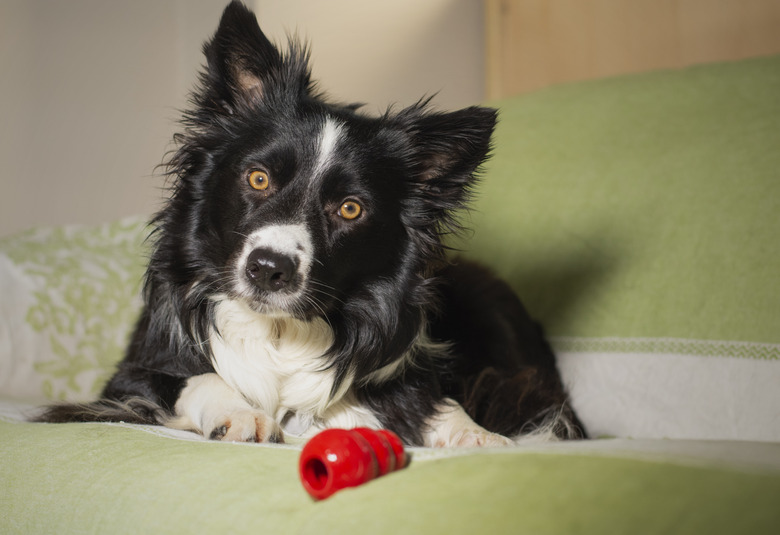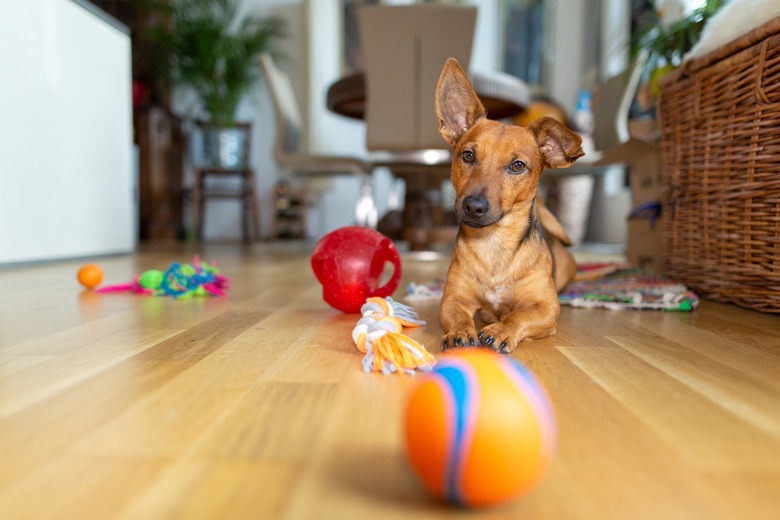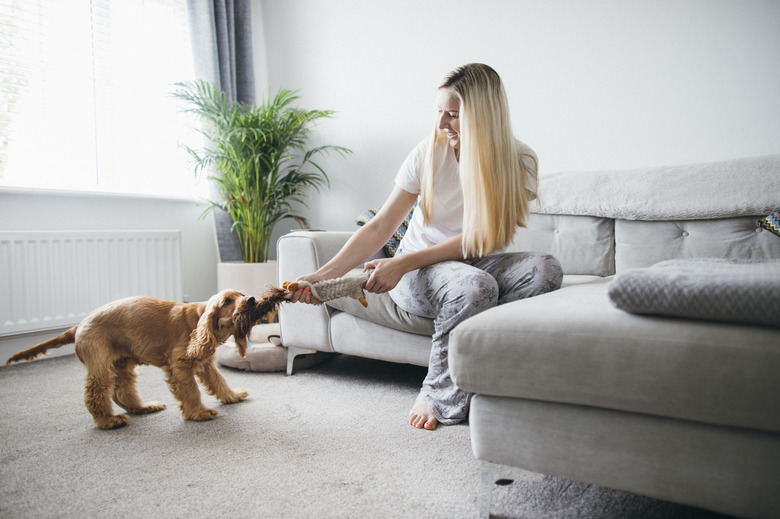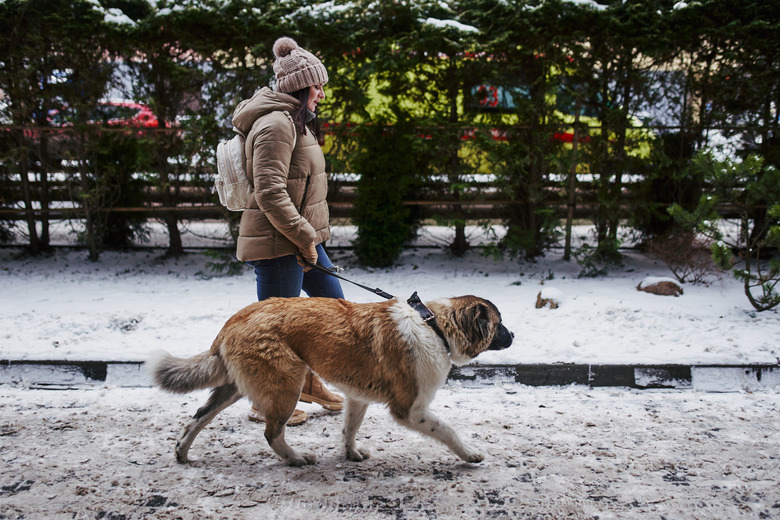How To Exercise Your Dog On Rainy Days Or Snow Days
Winter weather is here, but that does not mean your dog has to be bored or lose out on daily exercise! Even if it is too wet or cold outside, there are a variety of ways dogs can stay fit and active — without leaving the house. Indoor physical enrichment activities can include exploring, indoor exercise, and games. You can also provide your dog with mental exercise which is just as beneficial to keeping your dog active and healthy during the wintertime.
The importance of giving your dog enough exercise, even in bad weather
The importance of giving your dog enough exercise, even in bad weather
Just because the weather is bad doesn't mean your dog should sit around all day. A dog needs to stay physically and mentally active during the winter. Regular exercise helps your dog to continue looking and feeling their best. Exercise is also key to preventing some behavioral issues.
Dogs who are getting regular exercise and mental stimulation are less likely to be bored. They may display fewer undesirable behaviors such as excessive barking and chewing. Regular exercise can also help your dog stay active as they age. Exercise can prevent the worsening of age-related conditions such as arthritis.
Tips for exercising your dog in bad weather
Tips for exercising your dog in bad weather
Bad weather is somewhat subjective for both dogs and people. Some people enjoy being out in the snow or rainy day weather and are unbothered by most cold weather. The same is true with dogs. Your dog's cold tolerance should dictate how much time you spend outside during the winter. Dogs who have lived in warm climates will struggle to adjust if they have moved to an area with colder weather.
For small dogs and dogs with thin coats, anything under 45 degrees may be too cold for spending much time outside. In general, any temperatures under freezing can be dangerous for dogs and should be avoided for long periods of time.
Any temperature under 20 degrees is too cold for dogs and can lead to hypothermia and frostbite. Depending on your dog's health and age, temperatures that are above freezing can also be too cold for them. Senior dogs can struggle with extreme temperatures in general — especially with cold weather. Talk with your dog's veterinarian to assess how cold is too cold for your dog. Discuss when it's best to keep your dog indoors.
Tips for puppies in bad weather
Tips for puppies in bad weather
Puppies are susceptible to struggling with extreme temperatures, especially cold weather. For their comfort and health, it's best to keep young puppies out of the cold weather — apart from quick potty breaks. Cold temperatures, rain, and especially snow can be challenging for young puppies. Therefore it's best to focus on getting a puppy's exercise needs met indoors on a rainy or snowy day.
Exercise your dog indoors on rainy days or snow days
Play games with your pooch
An easy way to channel some of your dog's energy and provide some mental exercise during bad weather is to increase their enrichment. You can do this by making sure your dog has access to (dog-safe) chews and toys.
You can also make your dog's mealtimes more interesting by feeding their food in snuffle mats, treat dispensing balls, and other puzzle toys. This will help them to eat slower. It can also encourage them to play with their food and get some physical activity at the same time.
The nose knows
A perfect indoor activity and a fun way to give your dog some mental and physical exercise while keeping warm inside are to play scent work games with your dog. Scent games use a dog's nose and natural instincts to explore. This provides them with mental and physical exercise all while staying warm inside. Start by hiding dog treats or one of your dog's favorite toys in easy-to-find locations for your dog.Increase the difficulty level by putting the treats or toys behind furniture, on shelves, or under pillows.
You can even use these skills to earn scent work titles at home with your dog through the American Kennel Club's Virtual Scent Work program. This program is for mixed-breed and purebred dogs. You can also play hide and seek with your dog by hiding in areas around the house and having your dog search for you.
Learn some new tricks
If you're wanting to keep your dog active while inside, consider taking some time to teach your dog new tricks. You can absolutely teach old dogs new tricks. In fact, dogs of all sizes and ages can learn new tricks.
Tricks are an excellent way to provide your dog with some much-needed indoor exercise during the cold winter weather. Teaching your dog new tricks is a fun way to connect and bond with your dog. They can also help increase your dog's confidence while keeping them active indoors. A training session of just a few minutes a day can help your dog.
Play a game of fetch
If you have a dog who loves to play fetch you can still play their favorite game even in bad weather. When playing fetch indoors, use soft toys that are less likely to break or damage anything when in motion. Find an open area of your house such as a living room to play. Make sure your dog has good traction in the location where you are playing.
If you have hardwood or tile floors, consider getting an inexpensive carpet runner. This can ensure your dog will be able to chase their favorite toys without slipping. A carpet runner can help them avoid injuries while playing.
Tug-of-war
If your dog has more of a "no take, only throw" philosophy when it comes to playing ball, a fun way to get exercise might be a tug-of-war. This game doesn't take up much space and it's great exercise. They sell tug toys, but in a pinch, you can roll up an old towel and put a knot at each end.
Build an obstacle course
Try creating an indoor DIY obstacle course at home for your dog. You can even build a challenging and fun agility course with supplies you already have around the house.
Make sure that you have a supportive surface to play on such as a carpet to prevent your dog from slipping. The surface should provide cushioning for when your dog lands from jumping. Use treats and praise to encourage your dog to move through their indoor agility course.
Here are ideas to create elements of an agility obstacle course.
- Use broomsticks balanced on
canned foods or small boxes to create jumps. - Use clean toilet plungers for weave poles.
- Use an ottoman for a pause table.
- Use
large boxes open on both ends or hang a blanket between the backs of chairs for a tunnel.
Brave the storm
Brave the storm
If you have a dog who doesn't seem bothered by the cold or wet weather, one option is to head outside and brave the storm to get some exercise and playtime while outside. Your dog's tolerance and comfort being outside are going to depend a lot on their age (younger and older dogs get cold easier), coat type, and breed.
Many northern dog breeds were specifically developed with a thick undercoat that helps to protect and insulate them from cold air, wet snow, and wind. There is a common saying "if you're cold, they're cold" regarding temperature comfort levels. While this phrase may be true for most dog breeds, there are exceptions. Certain dog breeds have a much higher tolerance for cold weather temperatures even compared to people. These breeds include:
- Anatolian shepherds
- huskies
- sled dogs
- most
livestock guardian breeds
Many of these dogs even thrive in colder climates and will be begging to get outside in the cold for some exercise.
Tips to help your dog stay comfortable outdoors
If you want to head out in the cold with your dog, here are some tips to help your dog stay comfortable for outdoor dog exercise.
- Keep a time limit. The amount of time spent outside in cold weather should be up to 30 to 40 minutes at the most.
- Dress warmly. Bundle your dog up in a dog coat and boots if they have thinner fur and sensitive paws.
- Practice winter hygiene. Be sure to wipe the salt
off your dog's paws and snow off their fur. If you bring toys outside, be sure to clean them as well.
The bottom line
The bottom line
Just because the weather outside is cold and wet doesn't mean you have to sacrifice keeping your dog active. This winter with careful planning you can make sure your dog is getting all the exercise they need. When the weather is too cold and wet to be outside there are plenty of games and activities you can do inside to keep your dog active.




